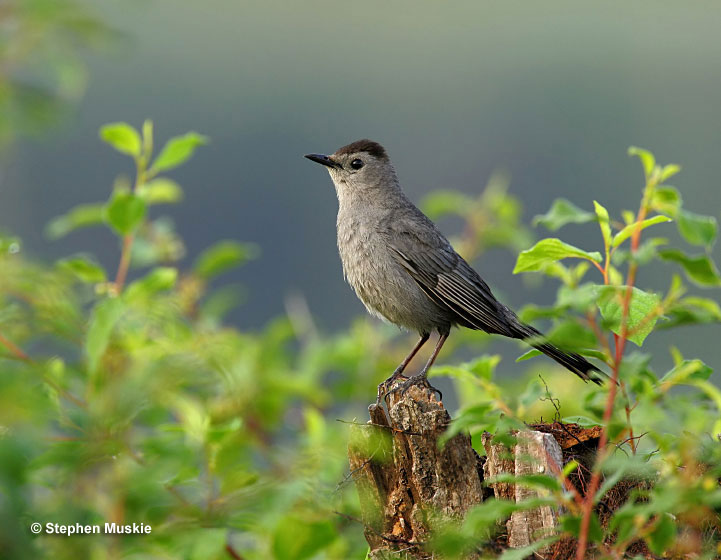The Gray Catbird is a slender, medium-sized songbird. They have rounded, long black tails and straight, narrow bills. Additionally, Catbirds have rounded, broad wings and long legs.
Gray Catbirds have one of the most recognizable calls. Follow the call into vine tangles and thickets, and you’ll be rewarded.
These birds are relatives of thrashers and mockingbirds; they share their vocal abilities, copying the sounds of other bird species and piecing them together to make their own songs.
On this page
Identification
Male Gray Catbirds look slate gray overall from afar. However, if you take a closer look, you’ll see a blackish tail, a rufous-brown patch under the tail, and a small black cap.
These birds are 8.3 to 9.4 inches, weigh 0.8 to 2.0 ounces, and have a wingspan of 8.7 to 11.8 inches.
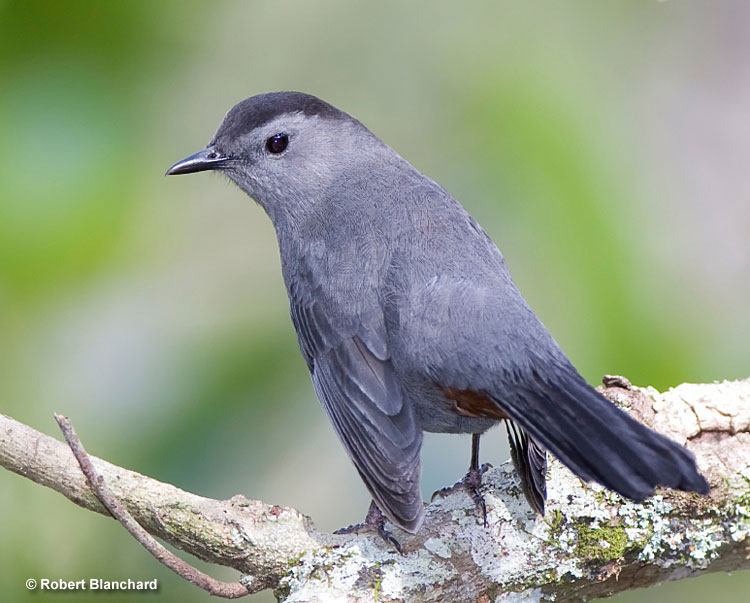
Female Gray Catbirds look identical to breeding male Gray Catbirds. They’re the same size and length and have the same wingspan as breeding males. They also weigh the same amount.
Food
The diet of a Gray Catbird varies. In the summer months, Gray Catbirds mainly consume beetles, ants, grasshoppers, moths, caterpillars, and midges.
However, when fruit is available, they’ll consume cherries, holly berries, elderberries, greenbrier, poison ivy, blackberries, and bay. As a result, these birds are sometimes considered to be garden pests. This is because they consume or damage cherries, raspberries, strawberries, and grapes.
Nesting and Eggs
Catbirds often create their nests on horizontal branches that are hidden in small trees, vines, or dense shrubs. Some plant species they’ll use include hawthorn, dogwood, cherry, elderberry, rose, grape, blackberry, and honeysuckle. Nests are usually about 4 feet off the ground, but this does vary. Some nests have been observed on the ground, while others have been as high as 60 feet.
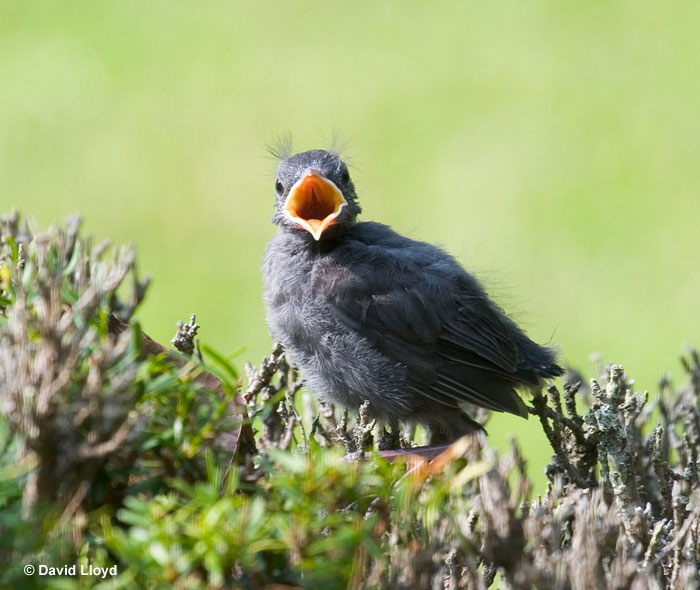
Young Gray Catbird
Female Gray Catbirds are the ones to create the nest, with males sometimes bringing materials. Nests take about a week to build. The final nest is an open cup made of straw, twigs, bark, pieces of trash, and mud. It has an inner lining that is woven of hair, grass, pine needles, and rootlets. Completed nests are about w inches tall and 5.5 inches wide.
These birds can have up to three broods during the breeding season. The clutch size can range from 1 to 6 eggs. Interestingly, Gray Catbird eggs have distinctive turquoise green eggs that are sometimes adorned with small red blotches.
Gray Catbirds incubate their eggs for 12 to 15 days. After that, the young stay in the nest for 11 days.
Current Situation
Gray Catbirds are common birds. Their populations have been stable from the late 1960s to 2019. Their breeding population is around 29 million. According to the IUCN Red List, they have a stable population and are a species of least concern. This means they’re a species of low concern.
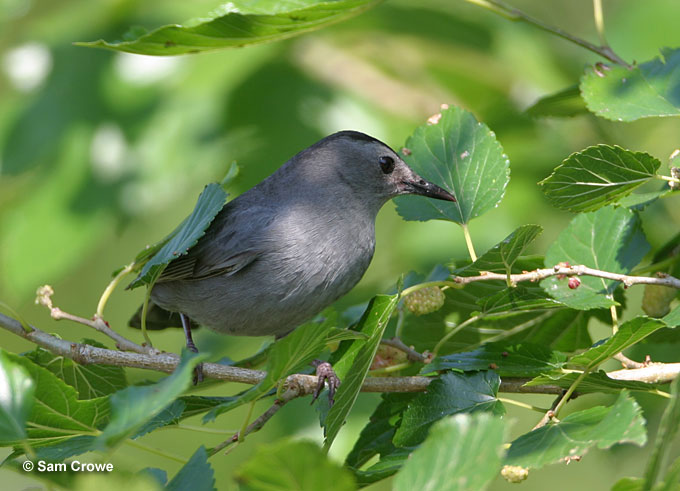
Gray Catbirds tend to spend their winters near the coast, making the development of coastal habitat a possible problem for these birds. A lot of Gray Catbirds are killed by cars when flying over roads.
Gray Catbirds live in vine tangles, young tree thickets, and dense shrubs in the winter and summer months.
Human development and disturbance often create these kinds of habitats in the form of roadsides, clearings, fencerows, residential areas, and abandoned farmland. However, on their tropical wintering grounds, these birds spend more time in forests.
Facts
- A group of catbirds is called a “seat” or “mewing” of catbirds.
- Gray Catbirds have one of the most recognizable calls. It’s where it got its name from, its cat-like call.
- Gray Catbirds have a resting heart rate that fluctuates between 307 to 427 beats per minute, which is considerably higher compared to the average human heart rate of 60 to 100 beats per minute.
- Catbirds are known for making their presence known with vocalizations. You’ll hear them before you see them. These birds are secretive and often swiftly dart into bushes or foliage when spooked.
Similar Species
The Gray Catbird has features that are similar to other bird species. Here are some similar species:
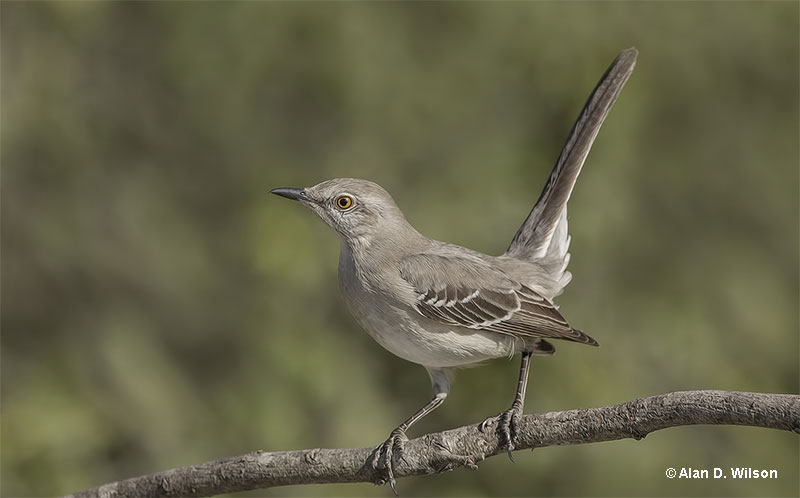
Northern Mockingbird. © Alan D. Wilson
The Gray Catbird and Northern Mockingbird show distinct differences in various aspects.
In terms of size, Catbirds are smaller than Mockingbirds. When it comes to coloration, Catbirds have a lead-gray plumage with a dark head, while Mockingbirds display gray upperparts, white underparts, and white wing bars.
Catbirds have black eyes, while Mockingbirds have yellow eyes.
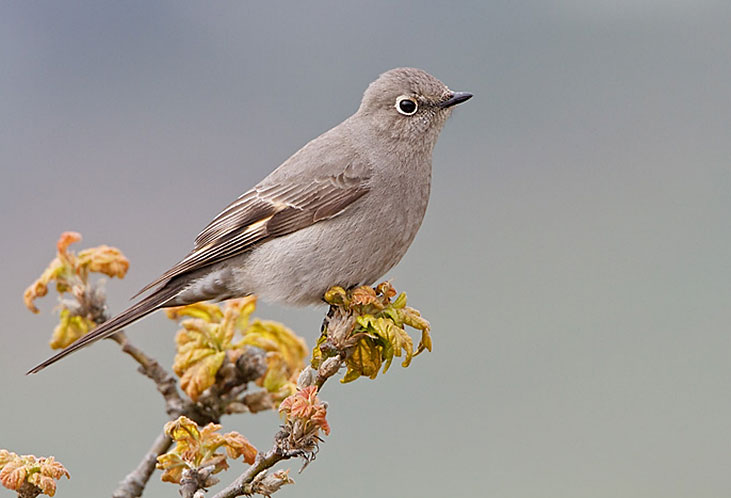
Townsend’s Solitaire
Gray Catbirds have lead-gray plumage with a dark head, whereas Townsend’s Solitaires present a paler gray coloration overall.
Additionally, their behaviors starkly contrast with one another.
Townsend’s Solitaires are often seen perched on exposed, elevated spots, while Gray Catbirds prefer to frequent shrubbery and vegetation.
Female Brown-headed Cowbird
Female Brown-headed Cowbirds possess a darker overall appearance, while Gray Catbirds have a distinct dark gray plumage.
Furthermore, Gray Catbirds are characterized by their thin bills, whereas Brown-headed Cowbirds have conical bills.
Frequently Asked Questions
Is a Gray Catbird a mockingbird?
No, the Gray Catbird is not a mockingbird. However, these birds are relatives of thrashers and mockingbirds; they share their vocal abilities, copying the sounds of other bird species and piecing them together to make their own songs.
Why do they call it a catbird?
Gray Catbirds have one of the most recognizable calls, which is where it got its name from. It has a cat-like call.
Are Gray Catbirds rare?
No, Gray Catbirds are not rare. Their estimated breeding population is 29 million, and can be found across a good portion of North America, making them a widespread bird.
Where are Gray Catbirds found?
Gray Catbirds live in vine tangles, young tree thickets, and dense shrubs in the winter and summer months. Human development and disturbance often create these kinds of habitats in the form of roadsides, clearings, fencerows, residential areas, and abandoned farmland. However, on their tropical wintering grounds, these birds spend more time in forests.
Are Gray Catbirds friendly?
Yes, Gray Catbirds can be friendly! With some light persuasion, people have been able to gain a catbird’s trust and develop a friendship with them.

